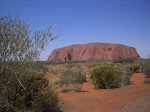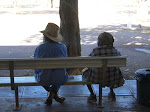Plan Your Trip Around The Weather
As you read this please keep in mind that in Australia is the "Land Down Under". We refer often to specific months but remember references to the Seasons - Summer, Fall, Winter and Spring - may be the opposite of where you live.
We have found that travel in September and October, the "Australian Spring" is very pleasant in most areas of the country. October is mild with very little rainfall and makes for a good visit before the rainy season to come.
In some seasons rainfall can be a serious problem. Some of the more notable rain measurements below are in both millimeters and inches. To convert the others, and for C to F temperature conversions, see the Conversion Table links at the end of the Post.
 In flood areas there are markers that indicate water depths for that area. Markers are individual for the area in which they are located. This was one of the highest water level markers we encountered.
In flood areas there are markers that indicate water depths for that area. Markers are individual for the area in which they are located. This was one of the highest water level markers we encountered.
Northern Territory
Rainfall varies from an average 1570 mm a year in the far north to less than 150 mm in the south. About two-thirds of the Territory receives less than 500 mm a year.
In the north, monsoonal influences produce two definite seasons known locally as "the wet" (November to April) and "the dry" (May to October). During the wet season, the coast is subject to tropical cyclones (hurricanes or typhoons).
The temperature in Darwin remains almost constant throughout the year. The daily average maximum in January is 31.8 C and the average minimum 24.8 C. In July, the average maximum is 30.3 C and the minimum 19.3 C.
Although most tourists come in the dry season the wet season, now also marketed as the green season, also has its attractions.
 High bumpers and Special Air Breathers for travel in the flood areas are commonly found on the vehicles used by the locals. Notice also the special radio phone antennas, extra lighting and heavy duty bumpers.
High bumpers and Special Air Breathers for travel in the flood areas are commonly found on the vehicles used by the locals. Notice also the special radio phone antennas, extra lighting and heavy duty bumpers.
Those big bumpers are for a reason. On the highways do not drive after sundown because that is when the kangaroos come out from the daytime shade spots and start to roam. Even in the cities be careful about driving at night as some wild Kangaroos may surprise you. Although Kangaroos are the main danger, most Australian Cattle Ranches are to big to fence and an occasional stray will get onto to the highway.
Queensland
Queensland is known as Australia’s "sunshine state" although weather conditions vary greatly between the coastal plain and the inland.
Brisbane averages 7.1 hours of sunshine a day in "Australian Winter". Inland, the days are warm and sunny and the nights cold and frosty, particularly in the south.
Queensland’s wet season is from December to March, when the northwest monsoons sweep down from Asia and cyclones are most prevalent. Annual rainfall can exceed 4000 mm in the north, in 2002 the rainfall was up to 7000mm.
Although the rains can be heavy and cut you off for a day or so, it is an interesting time to visit as as the rainforest and creeks are at their wildest best during this time.
In the north-west, the city of Mount Isa averages less than 400 mm of rain a year and the average dwindles to about 200 mm in the south-west corner. Brisbane, on the coast, averages 1200 mm.
The peak season of July and August in North Queensland gets cool nights as low as 13 degrees and often strong winds. The end of the year is a better time for water based activities like reef trips and sea kayaking as the oceans are usually calm and the rains do not usually set in untill early February.
New South Wales
Daily "Australian Summer" temperatures range from 14 to 23 C in the coastal areas, 11 to 20 C in the mountains and 16 to 31 C inland.
In the "Australian Winter", temperatures range from 7 C to 14 C in coastal areas, 0 C to 5 C in the mountains and 5 C to 16 C inland.
Snow settles on the Australian Alps in the north-east of Victoria from June to September.
New South Wales lies in the temperate zone and the climate is generally free from extremes of heat and cold. The greatest heat is usually experienced in the north-west; a shade temperature of more than 51°C has been recorded at Bourke. The coldest region is the Snowy Mountains, where "Winter" frosts and snow are experienced over long periods.
Rainfall varies widely over the state, gradually diminishing to an annual average of 180 mm in the far north-west.
Temperatures vary widely but most of the State falls within the warm, temperate belt of the south-east corner of Australia, characterized by warm and dry "Australian Summers" and cool to mild, wet, "Winters".
Victoria
Rainfall is heaviest in the eastern highlands, in Gippsland in the east of the State and in the Otway Ranges in western Victoria. Some areas receive annual rainfalls of more than 1000 mm. Lowest falls are in the Mallee region, where the average is 327 mm. Melbourne’s average rainfall is about 660 mm a year.
South Australia
South Australia enjoys hot dry "Australian Summers" with relatively mild nights and cool winters, with most rainfall occurring during May to August.
Adelaide's average daily maximum temperature in January is 29°C, and in July 15°C.
South Australia is the driest of the Australian States and Territories with most of the rainfall occurring during May to August. South Australia's average annual rainfall is 528 mm, but just over 80 per cent of the State receives an average of less than 250 mm of rain a year.
Western Australia
From its tropical north, to temperate areas in its south-west corner, Western Australia experiences a variety of climatic conditions. With greater distance from the coast, rainfall decreases and temperature variations are more pronounced.
Perth averages eight hours sunshine per day and 118 clear days per year. Mean monthly maximum temperatures range from 17ºC in July to 30ºC in February. Even in the coldest months, minimum temperatures rarely fall below 5ºC.
Most of Western Australia's 802mm annual rainfall occurs in the "Australian Winter" months.
Tasmania
The cool temperate climate of Australia's island state, with its distinctive four seasons, makes this place ideal for year-round comfortable living and touring.
The long "Australian Summer" evenings provide opportunity for extended sight-seeing with darkness coming slowly.
Although the island is small compared to the mainland it still has variations in weather -- the Tasmanian East Coast is milder, the West Coast wetter and the NW Coast windier.
The occasional deep low in the Southern Ocean, usually in the "Australian Springtime", can produce a severe gale winds.
During the "Australian summer, autumn and winter" there are successive days of calm and balmy weather with regular afternoon coastal sea breezes from October through to May.
For current weather conditions in the various states visit
Useful Conversion Calculators:
| Area
| Speed |
 The National Public Toilet Map (the Toilet Map) shows the location of more than 14,000 public and private public toilet facilities across Australia.
The National Public Toilet Map (the Toilet Map) shows the location of more than 14,000 public and private public toilet facilities across Australia.
The Toilet Map is funded by the Australian Government providing the location of the nearest public toilet and the details of opening hours, handicap accessibility, parking and other features.
The Toilet Map is convenient for people with young families and those holidaying or traveling to new locations as it allows you to:
- browse the map in a particular State/Territory
- search for toilets by postcode, town or suburb, near a specific address or location such as a sports ground
- plan a trip with the Trip Planner and enter your starting and end address to get a turn by turn description for the quickest route and the toilets along the way.
- find the nearest public Caravan Dump Points
Click on the banner below for access to the Public Toilet Map
The National Public Toilet Map is available on any mobile phone with an Internet browser. Go to m.toiletmap.gov.au on your phone to be automatically directed to the mobile site.
The National Public Toilet Map is also available for Apple's iPhone. Just go to the App Store on your iPhone or use iTunes to download the National Public Toilet Map App. It's free.


















